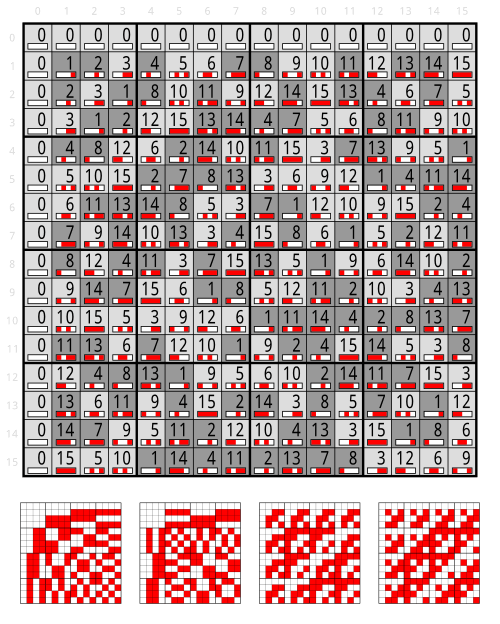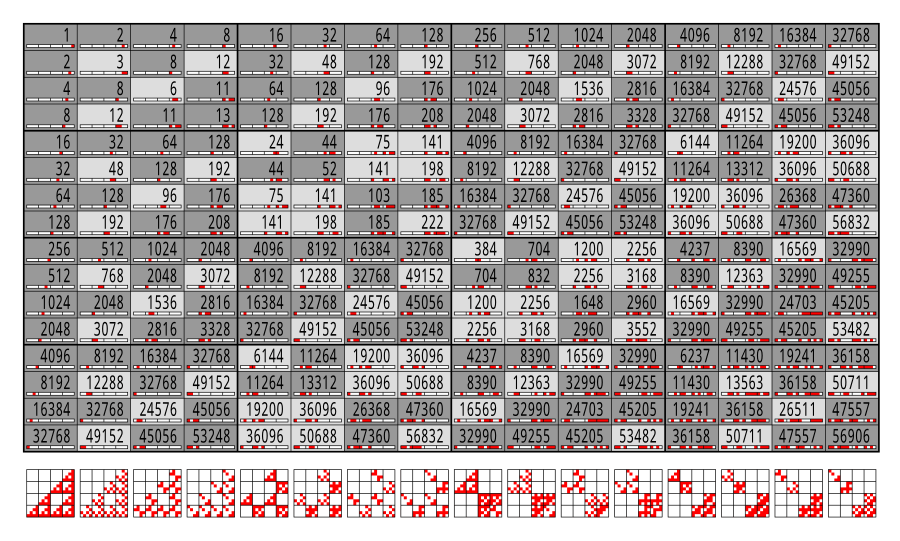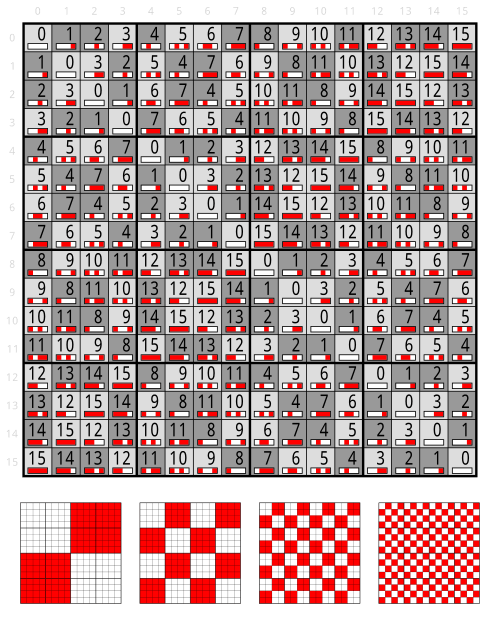Nimber
In mathematics, the nimbers, also called Grundy numbers, are introduced in combinatorial game theory, where they are defined as the values of nim heaps. They arise in a much larger class of games because of the Sprague–Grundy theorem. The nimbers are the ordinal numbers endowed with a new nimber addition and nimber multiplication, which are distinct from ordinal addition and ordinal multiplication.
Properties
The Sprague–Grundy theorem states that every impartial game is equivalent to a nim heap of a certain size. Nimber addition (also known as nim-addition) can be used to calculate the size of a single heap equivalent to a collection of heaps. It is defined recursively by
where for a set S of ordinals, mex(S) is defined to be the "minimum excluded ordinal", i.e. mex(S) is the smallest ordinal which is not an element of S.
Addition
For finite ordinals, the nim-sum is easily evaluated on a computer by taking the bitwise exclusive or (XOR, denoted by ⊕) of the corresponding numbers. It can also be evaluated by hand by adding the binary representations of the corresponding numbers and treating even digits as 0. For example, the nim-sum of 7 and 14 can be found by writing 7 as 111 and 14 as 1110; the ones place adds to 1; the twos place adds to 2, which we replace with 0; the fours place adds to 2, which we replace with 0; the eights place adds to 1. So the nim-sum is written in binary as 1001, or in decimal as 9.
This property of addition follows from the fact that both mex and XOR yield a winning strategy for Nim and there can be only one such strategy; or it can be shown directly by induction: Let α and β be two finite ordinals, and assume that the nim-sum of all pairs with one of them reduced is already defined. The only number whose XOR with α is α ⊕ β is β, and vice versa; thus α ⊕ β is excluded. On the other hand, for any ordinal γ < α ⊕ β, XORing ξ := α ⊕ β ⊕ γ with all of α, β and γ must lead to a reduction for one of them (since the leading 1 in ξ must be present in at least one of the three); since ξ ⊕ γ = α ⊕ β > γ, we must have α > ξ ⊕ α = β ⊕ γ or β > ξ ⊕ β = α ⊕ γ; thus γ is included as (β ⊕ γ) ⊕ β or as α ⊕ (α ⊕ γ), and hence α ⊕ β is the minimum excluded ordinal.
Multiplication
Nimber multiplication (nim-multiplication) is defined recursively by
- α β = mex{α ′ β + α β ′ − α ′ β ′ : α ′ < α, β ′ < β} = mex{α ′ β + α β ′ + α ′ β ′ : α ′ < α, β ′ < β}.
Except for the fact that nimbers form a proper class and not a set, the class of nimbers determines an algebraically closed field of characteristic 2. The nimber additive identity is the ordinal 0, and the nimber multiplicative identity is the ordinal 1. In keeping with the characteristic being 2, the nimber additive inverse of the ordinal α is α itself. The nimber multiplicative inverse of the nonzero ordinal α is given by 1/α = mex(S), where S is the smallest set of ordinals (nimbers) such that
- 0 is an element of S;
- if 0 < α ′ < α and β ′ is an element of S, then [1 + (α ′ − α) β ′ ]/α ′ is also an element of S.
For all natural numbers n, the set of nimbers less than 22n form the Galois field GF(22n) of order 22n.
In particular, this implies that the set of finite nimbers is isomorphic to the direct limit as n → ∞ of the fields GF(22n). This subfield is not algebraically closed, since no other field GF(2k) (so with k not a power of 2) is contained in any of those fields, and therefore not in their direct limit; for instance the polynomial x3 + x + 1, which has a root in GF(23), does not have a root in the set of finite nimbers.
Just as in the case of nimber addition, there is a means of computing the nimber product of finite ordinals. This is determined by the rules that
- The nimber product of distinct Fermat 2-powers (numbers of the form 22n) is equal to their ordinary product;
- The nimber square of a Fermat 2-power x is equal to 3x/2 as evaluated under the ordinary multiplication of natural numbers.
The smallest algebraically closed field of nimbers is the set of nimbers less than the ordinal ωωω, where ω is the smallest infinite ordinal. It follows that as a nimber, ωωω is transcendental over the field.[1]
Addition and multiplication tables
The following tables exhibit addition and multiplication among the first 16 nimbers.
This subset is closed under both operations, since 16 is of the form 22n
(If you prefer simple text tables, they are here.)

The nonzero elements form the Cayley table of Z15.
The small matrices are permuted binary Walsh matrices.

Calculating the nim-products of powers of two is a decisive point in the recursive algorithm of nimber-multiplication.
Notes
- ↑ Conway 1976, p. 61.
References
- Conway, John Horton (1976). On Numbers and Games. Academic Press Inc. (London) Ltd.
- Lenstra, H. W. (1978). "Nim multiplication". hdl:1887/2125.
- Schleicher, Dierk; Stoll, Michael. "An Introduction to Conway's Games and Numbers". arXiv:math.DO/0410026. which discusses games, surreal numbers, and nimbers.

